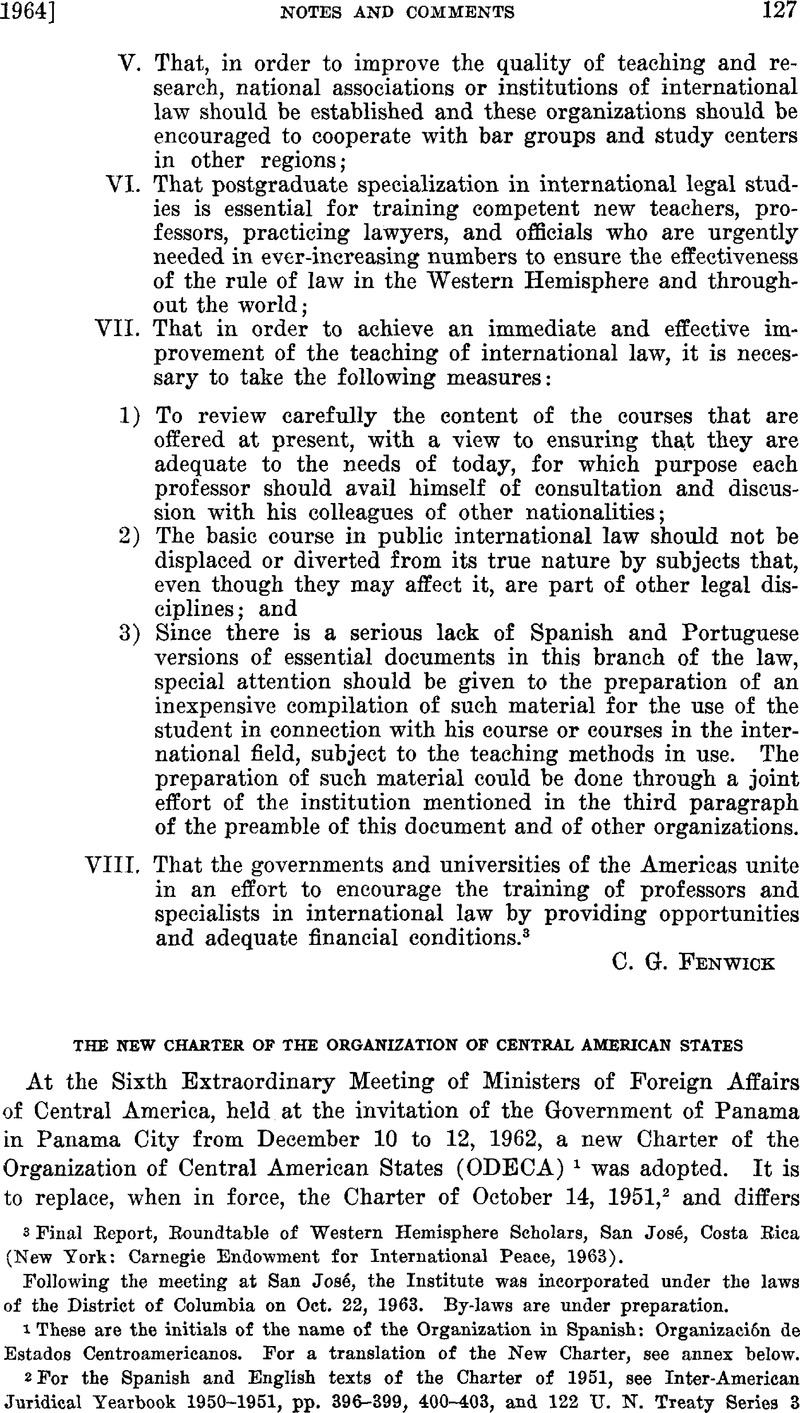Article contents
The new Charter of the Organization of Central American States
Published online by Cambridge University Press: 28 March 2017
Abstract

- Type
- Notes and Comments
- Information
- Copyright
- Copyright © The American Society of International Law 1964
References
Following the meeting at San José, the Institute was incorporated under the laws of the District of Columbia on Oct. 22, 1963. By-laws are under preparation.
1 These are the initials of the name of the Organization in Spanish: Organización de Estados Centroamericanos. Por a translation of the New Charter, see annex below.
2 For the Spanish and English texts of the Charter of 1951, see Inter-American Juridical Yearbook 1950-1951, pp. 396-399, 400-403, and 122 U. N. Treaty Series 3 ff. (1952). For the background and activities of ODECA see, inter alia, Fenwick, 46 A.J.I.L. 509 ff. (1952) and 49 ibid. 563 f. (1955) ; Hudson, The Permanent Court of International Justice 42 ff. (1943); Padelford, 11 International Organization 41 ff. (1957); Karnes, The Failure of Union, Central America, 1824-1960 (1961); Herrarte, La Union de Centroamerica, Tragedia y Esperanza (1955); Moses in Wilgus (ed.), The Caribbean: The Central American Area 243 ff. (1961); Inter-American Juridical Yearbook 1952-1954, pp. 84 ff.; ibid. 1955-1957, pp. 117 ff.
3 For the text of the Convention, see 2 A.J.I.L. Supp. 213 ff. (1908) ; Herrarte, Documentos de la Unión Centroamericana 191 ff. (1957) ; Papers relating to the Foreign Relations of the United States, 1907, II, 697 ff. (1910).
4 The term “convencionalmente” is, however, ambiguous.
5 Herrarte, op. cit. note 3 above, 196; U. S. Foreign Relations, op. cit. 701.
6 e An article annexed to the Convention contained an “amplification” of the jurisdiction of the Court to include “conflicts which may arise between the Legislative, Executive and Judicial Powers, and when as a matter of fact the judicial decisions and resolutions of the National Congress are not respected.” With the exception of Costa Rica, all parties to the Convention ratified this amplification. Hudson, op. cit. 45.
It will be recalled that a Convention for the Establishment of an International Central American Tribunal was signed at Washington on Feb. 7, 1923; see 2 Hudson, International Legislation 908 ff. ; Herrarte, op. cit. note 3 above, 303 ff. ; 3 Mendoza, Tratados y Convenciones Internacionales Vigentes para Guatemala: Pactos Multilaterales Centroamericanos y Regionales 7 ff. (1960). However, no tribunal was organized under the Convention, although it was ratified by Costa Rica, Guatemala, Honduras (which denounced it in 1953) and Nicaragua, and came into force in 1925. Hudson, The Permanent Court, op. cit. 68; Mendoza, op. cit. 7.
7 The text of this draft has been supplied by Lic. Mareo Tulio Zeledon, Secretary General of ODECA.
8 On Central American economic integration, see Urquidi, Free Trade and Economic Integration in Latin America 90 ff. (1962) ; Keller, 5 Journal of Inter-American Studies 267 ff.; Rivero, 15 Americas 3 ff. (1963); Staley, 29 The Southern Economic Journal 88 ff. (1962).
9 Moses, loc. cit. 247; Inter-American Juridical Yearbook 1955-1957, p. 117.
10 See also III, below, on the ad hoc Committee of Ambassadors on the accounts and assets of ODECA.
11 Acta Final de la Sexta Reunión Extraordinaria de Ministros de Relaciones Exteriores de Centro America, p. 11; text supplied by Dr. Galileo Solis, Minister of Foreign Affairs of Panama.
12 Discurso pronunciado por S.E. el Dr. Galileo Solfs, Ministro de Relaciones Exteriores de Panamá el 10 de díciembre de 1962; text supplied by Dr. Solí.
13 On Jan. 9, 1952, and not, as generally assumed, on Dec. 14, 1951 ; see 122 U. N. Treaty Series 10 (1952). For the entry into force of the new Charter, see Art. 29 of 1962.
- 3
- Cited by


